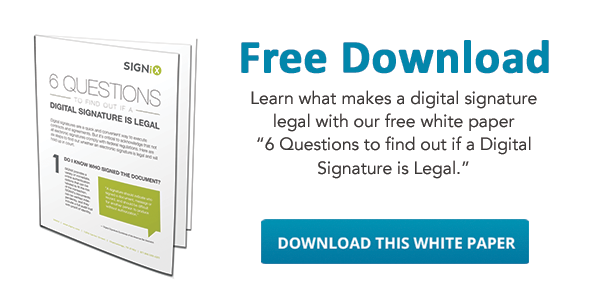 As more companies use e-signatures, the more often e-signatures (and their legality) are being resolved in court. As I recently wrote in a piece on the legal pros and cons of electronic signatures in the United Kingdom, an e-signature can be much harder to forge than a traditional wet signature, especially if the correct procedures are in place.
As more companies use e-signatures, the more often e-signatures (and their legality) are being resolved in court. As I recently wrote in a piece on the legal pros and cons of electronic signatures in the United Kingdom, an e-signature can be much harder to forge than a traditional wet signature, especially if the correct procedures are in place.
But as a higher number of electronic transactions take place each year, it’s still important to understand how to best conclude a contract electronically—both in your own country and abroad.
Here are three marks of a sound, legal e-signature in the United States and across the pond in the European Union, via the EU Directive’s Advanced Electronic Signature (AES) and recommendations from the American Bar Association’s Digital Signature Guidelines.
EU: The e-signature is linked to the signatory and is capable of identifying the signatory.
US: The signer must be authenticated, and there must be disclosure and consent.
It’s always important to know whom exactly you’re doing business with, especially when signing contracts. Using identity authentication methods with e-signatures can enable signers to prove their identity by confirming their username and password, date of birth, social security number, etc. In the US, signers must also realize they are signing a legal document, which they must approve before signing.
EU: It is created using means that the signatory can maintain under their sole control. US: All signers should have access to the document, and all actions taken should be documented.
Signature verification data under AES can include location data and IP addresses, which should be captured at the time of signing for evidential purposes. The ABA’s guidelines suggest maintaining a detailed log of events, or an audit trail, of every action taken on a document.
EU: It is linked to the data to which it relates in such a manner that any subsequent change in the data is detectable.
US: The document must be secure from tampering.
Finally, if a document is tampered with or a signature is forged, the system must be set up in such a way that tampering is evident. There’s always a risk of hacking, but with the right technology, e-signed documents can be even more secure against tampering than their paper counterparts.
While there are still a number of binding contracts that may require handwritten signatures in both the US and the EU, most contracts can take advantage of the efficiency and convenience offered by e-signatures. And by heeding the best practices of both countries, your e-signed documents can move freely across international borders with your business.
Want to learn more about what makes a digital signature legal in the US? Download our free white paper.
The content of this bulletin is for general information only and should not be regarded as an exhaustive analysis of the law. It is provided to the public free of charge, does not constitute legal advice and must not be relied upon as such to make any decisions. For that reason users should seek specific legal advice about any matter which concerns them.
Andrew Foyle is a partner at Shoosmiths LLP, a major UK law firm with a network of offices working together as one national team. Andrew has over a decade’s experience with the full range of banking disputes and insolvency litigation at all levels of the court system in Scotland, including debt recovery, professional negligence and fraud. He is also a solicitor advocate giving him rights of audience to appear in the Supreme Courts. Connect with him on LinkedIn.
%20formatted-1.png?width=2528&height=739&name=SIGNiX%20Logo%20Main%20(white)%20formatted-1.png)

